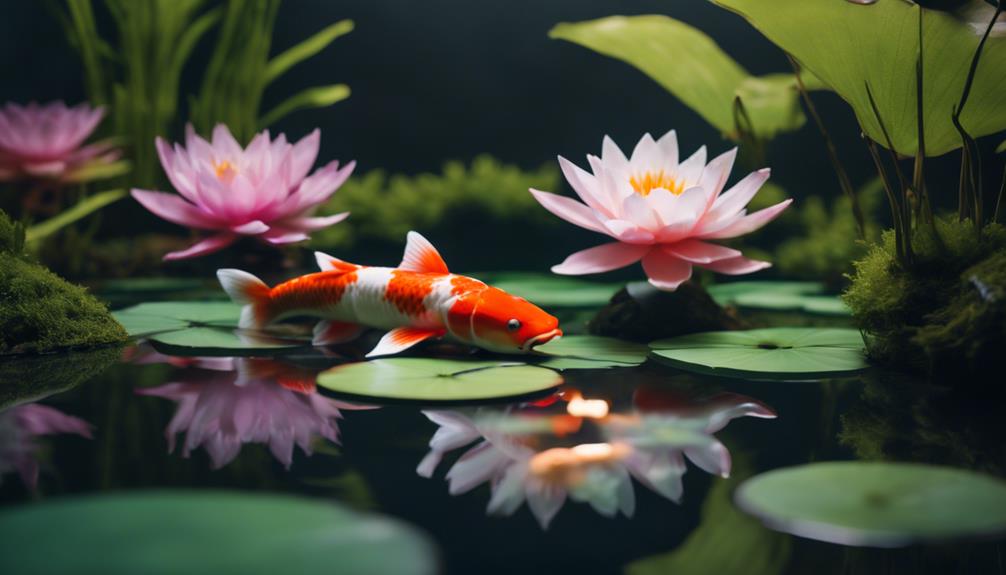To breed koi fish successfully, you'll need to establish a dedicated breeding environment with a reliable filtration system, separate from your main koi pond. Select breeding stock based on physical characteristics, genetic diversity, and health. Guarantee the pond is predator-free, and ideal water conditions are maintained. Trigger spawning by manipulating water temperature, quality, and chemistry. Provide a safe environment for koi fry, feeding them a nutrient-rich diet. Be prepared to manage risks and address breeding complications. By following these essential methods, you'll be well on your way to breeding healthy, vibrant koi – and with attention to detail, you can reveal even more secrets to success.
Table of Contents
Key Takeaways
- Establish a dedicated breeding environment with a reliable filtration system to maintain ideal water conditions and prevent stress.
- Select healthy, vibrant breeding stock with desirable characteristics, such as scale quality, color patterns, and genetic diversity.
- Manipulate water temperature, quality, and chemistry to create an ideal environment that triggers koi fish to spawn successfully.
- Provide a safe and nutritious environment for koi fry, including a varied diet and predator-free space, to promote healthy growth and development.
- Monitor and manage risks, including offspring populations, female health, and financial investments, to ensure a successful breeding program.
Preparing a Breeding Environment
Establishing a dedicated breeding environment is crucial for successful koi fish reproduction, as it allows you to carefully control water quality, temperature, and other essential factors that influence the breeding process.
To breed koi, you'll need a special koi pond designed specifically for breeding, equipped with a reliable koi pond filtration system to maintain ideal water conditions. This breeding pond should be separate from your main koi pond to prevent stress and safeguard the health of your breeding stock.
By creating the right conditions, you'll increase the chances of successful spawning. When you've set up your breeding pond, make sure it's free from predators and other disturbances that might disrupt the breeding process.
Once you've got everything in place, you can expect your koi will begin to spawn naturally. With the right environment and conditions, your koi will thrive, and you'll be well on your way to successfully breeding these beautiful fish.
Choosing the Right Koi
When selecting koi for breeding, you'll need to evaluate potential breeding stock based on specific criteria.
You'll want to examine each fish's physical characteristics, such as the quality of its scales, to certify you're choosing healthy individuals.
Koi Selection Criteria
To guarantee the best possible breeding outcomes, you'll want to select koi that meet specific criteria, as the quality of your breeding stock directly impacts the health and characteristics of their offspring.
When choosing koi, prioritize those that are at least 3 years old, as they're sexually mature and can produce healthy offspring.
Look for koi with desirable characteristics, such as vibrant color patterns, healthy fin shape, and a balanced body shape with symmetrical fins. These traits will increase the chances of passing them on to their offspring.
Avoid breeding koi with injuries, as they may sustain further damage during breeding and reduce the quality of their offspring.
Consider the genetics of the fish as well, as breeding koi with diverse genetic backgrounds can increase the chances of producing high-quality offspring with desirable traits.
Healthy Scales Matter
You'll want to examine the koi's scales closely, as healthy, vibrant scales are a key indicator of a fish's overall health and genetic quality, making them a vital selection criterion for breeding.
When selecting koi parents, look for those with vibrant, lustrous scales that reflect light. Dull or matte scales can indicate poor health or genetics, which you want to avoid passing on to your koi fry.
Scales that are symmetrical, well-defined, and evenly colored are desirable traits in koi breeding, as they indicate a strong genetic makeup. Avoid breeding koi with scales that are damaged, rough, or have uneven coloration, as these can be signs of genetic defects or poor environmental conditions.
Instead, choose koi with scales that have a good balance of color, pattern, and shine, as these are often indicative of a healthy and well-bred fish.
Additionally, inspect the pectoral fins for any signs of damage, such as torn fins, as these can also impact the koi's overall health and breeding potential.
Desired Traits Only
Selecting koi with specific, desirable traits is essential to producing high-quality offspring, as it allows breeders to intentionally pass on preferred characteristics to their fry.
When choosing male and female koi for breeding, you'll want to focus on specific traits such as fin shape, color, and pattern.
Breeding koi with healthy scales increases the likelihood of passing on this trait to their offspring.
Selecting parents between 4-5 years old can improve the quality of the offspring, as this age range is ideal for egg shell quality.
Understanding koi genetics and breeding principles is pivotal to making informed decisions about which traits to select for.
Creating Spawning Conditions
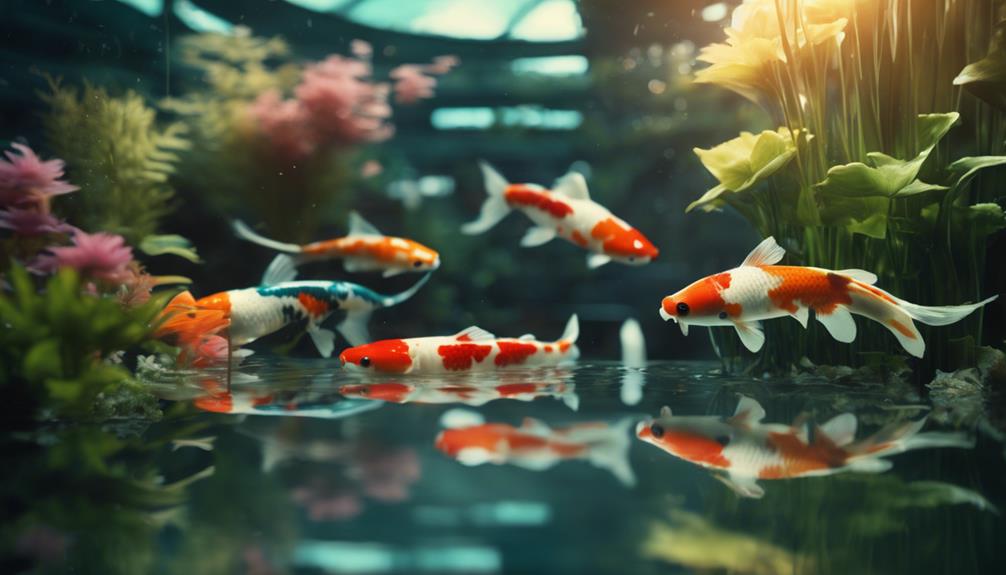
By manipulating water temperature, quality, and chemistry, you create an ideal environment that triggers koi fish to spawn.
Make sure the water temperature is between 64°F and 75°F (18°C and 24°C), as this range stimulates the mating season. You should also guarantee the water quality is pristine, with proper filtration and regular water changes. The full moon is a natural trigger for spawning, so plan accordingly.
To create an ideal spawning environment, provide a place for the female koi to lay her eggs.
You can add plants or spawning mats to the pond, giving her a safe and suitable location. Cover the pond with a net or mesh to prevent the eggs from being eaten by other fish. During this time, separate the male and female koi to prevent premature mating.
Once you've created the perfect conditions, introduce the male and female koi to the spawning area, and let nature take its course.
With these conditions in place, you'll be well on your way to successful koi breeding.
Understanding Koi Mating Rituals
As you prepare to breed your koi fish, knowing the basics is crucial to understand their mating rituals.
You'll need to recognize the subtle cues of the koi courtship ritual, which typically begins with the male koi displaying aggressive behavior towards the female.
Koi Courtship Ritual
During the koi breeding season, you'll observe a fascinating yet complex courtship ritual, characterized by males vigorously chasing females and nudging their sides with their mouth and fins to stimulate egg-laying.
This ritual usually takes place in late spring or early summer, when water temperatures are between 65°F to 70°F. As you watch, you'll notice the males' enthusiasm and persistence, which can be quite intense.
Pheromone guidance: The female koi releases a pheromone to guide the male to the spawning location, and this process is repeated until the female is exhausted.
Pre-spawning stress: The courtship ritual can be a stressful event for koi, so providing a safe and healthy environment is vital to minimize stress.
Spawning timing: Spawning usually occurs just before dawn, and you may need to remove the males to protect the females from injury or stress.
Understanding the koi courtship ritual is pivotal for successful breeding. By recognizing the signs and behaviors associated with this ritual, you can create a favorable environment for your koi to thrive and reproduce.
Koi Spawning Process
You'll witness a remarkable spectacle when your koi engage in the spawning process, a complex and intricate ritual that involves precise temperature and timing cues.
Typically, koi spawn when water temperatures are between 65°F to 70°F, usually in late spring or early summer between May and June. During this process, males will chase females, nudging their sides with their mouth and fins to encourage egg-laying.
You can identify males by the small white growths on their pectoral fins and heads during mating season, while females are usually larger and more rounded in the belly.
As the females lay their eggs, males will fertilize them, resulting in a cloudy or foamy water with a distinct odor. A froth or scum on the water surface indicates the presence of koi eggs.
Providing a safe and healthy environment for your koi during spawning is crucial, as this event can be stressful for them. By understanding the spawning process, you can optimize breeding conditions, increasing the chances of successful koi breeding.
Caring for Koi Eggs and Fry
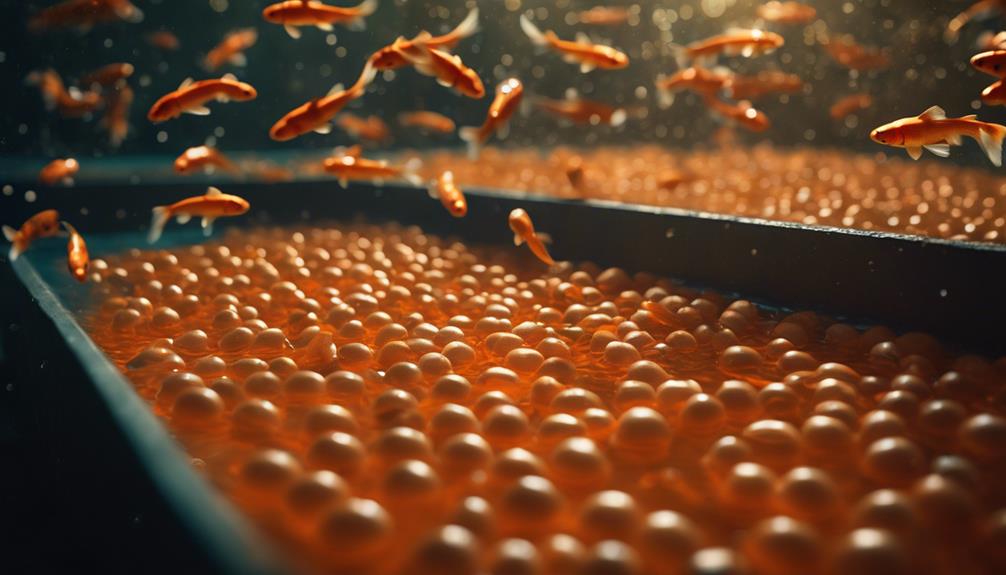
Frequently, koi breeders successfully navigate the critical first few weeks of caring for koi eggs and fry by meticulously controlling water quality and nutrition. This period is vital, as it sets the stage for healthy growth and development.
To guarantee the survival of your baby koi, you'll need to maintain peak water quality. Monitor ammonia levels, which should be zero, and provide adequate filtration to prevent water pollution.
Provide a safe environment. Use fine mesh tents or floating pond plants like water hyacinth and water lettuce to protect your koi fry from predators.
Offer a nutritious diet. Feed your fry a diet rich in protein, such as live foods like brine shrimp or commercial baby koi meal kits, 4-5 times a day for the first three months.
Feeding Koi Fry Correctly
When it comes to feeding koi fry correctly, it's vital to establish a precise feeding schedule and diet to promote ideal growth and development. You'll need to feed your koi fry 4-5 times a day for the first three months, with suitable food including infusoria, algae, and newly hatched brine shrimp.
| Age | Food | Feeding Frequency |
|---|---|---|
| 0-10 days | Powdered koi pellets | 4-5 times a day |
| 10-30 days | Small pellet pieces | 4-5 times a day |
| 30-60 days | Regular koi pellets | 3-4 times a day |
| 60-90 days | Varied diet (including brine shrimp) | 2-3 times a day |
| 90+ days | Regular koi pellets | 1-2 times a day |
As your fry grow, you can switch to regular koi pellets, but make sure to provide a varied diet to guarantee peak growth and development. Remember to only feed them as much food as they can consume within 5 minutes to prevent overfeeding and maintain good water quality. Monitor their growth and adjust the feeding schedule accordingly to prevent underfeeding or overfeeding, which can lead to stunted growth or water quality issues.
Maintaining a Healthy Pond
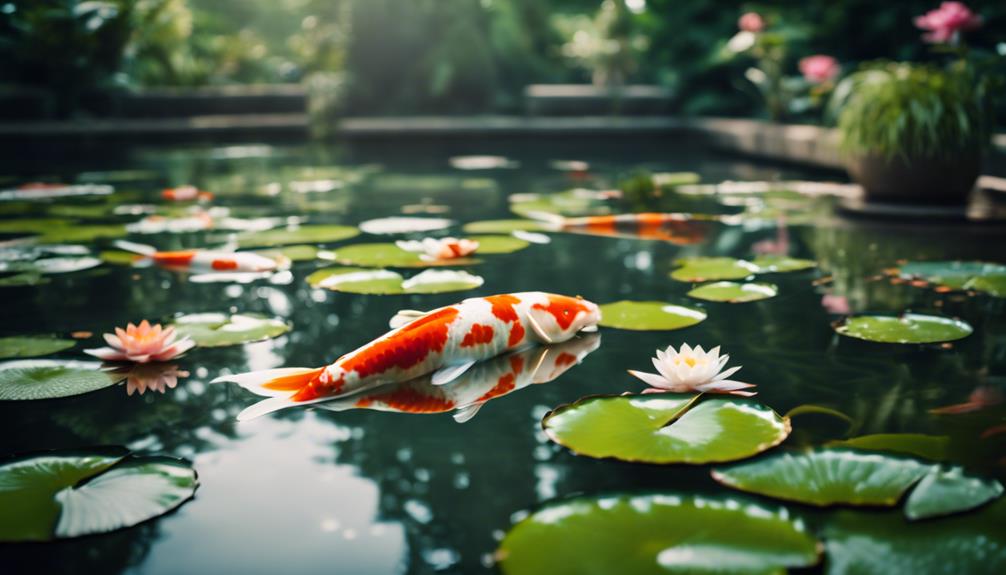
As you've carefully nurtured your koi fry through the feeding process, it's now imperative that you focus on maintaining a healthy pond environment, where water quality and cleanliness will play a significant role in the long-term health and well-being of your growing koi.
To achieve this, you'll need to perform regular maintenance tasks.
Perform regular water changes: Replace up to 10% of the pond water weekly to prevent the buildup of toxins and maintain superior water quality.
Maintain a functioning pond filtration system: Guarantee your system is working efficiently to remove waste and excess nutrients that can harm your koi.
Keep your pond clean: Use a skimmer net to remove debris and excess food from the surface, and consider removing the males to prevent over-breeding and reduce stress on the females.
Additionally, monitor air temperature and guarantee it remains within a comfortable range for your koi.
Managing Koi Breeding Risks
As you venture into koi breeding, you'll need to navigate the complexities of breeding complications and financial realities.
You'll face challenges like managing large numbers of offspring, dealing with the physical toll of breeding on your fish, and coping with the uncertainty of achieving desired traits.
Breeding Complications
You'll need to be prepared to address a range of breeding complications, from managing massive offspring populations to dealing with the physical toll on your fish. When you're trying to breed koi, understanding the potential risks involved is vital.
- Massive Offspring Populations: A single pregnancy can result in thousands of offspring, requiring you to cull the population to maintain a healthy environment.
- Challenging Color and Pattern Breeding: Breeding for specific colors and patterns can be extremely difficult and may take multiple attempts to achieve the desired outcome.
- Female Health Risks: Female koi may sustain wounds during breeding, making it vital to monitor their health and provide a safe environment to encourage the koi to thrive.
When you breed your koi, you're not just trying to produce more fish; you're also taking on the responsibility of caring for them. Breeding might seem exciting, but prioritizing the well-being of your fish and taking necessary precautions to mitigate these breeding complications is paramount.
Financial Realities
Breeding koi fish comes with a hefty price tag, requiring significant investments in equipment, facilities, and labor, which can quickly add up to thousands of dollars.
As you venture into koi breeding, you'll realize it's not just a hobby, but a full-time job that demands your attention and resources.
To be successful, you'll need to manage risks and invest wisely. Disease outbreaks, poor water quality, and predation can result in significant financial losses if not properly managed.
You'll need to cull your stock regularly, which can be emotionally challenging, but vital for maintaining the health and quality of your fish.
If you're breeding koi for profit, you'll need to be prepared to invest time and resources into marketing and selling your fish to pet shops or directly to customers.
Prices for koi can range from a few dollars for low-quality fish to thousands of dollars for high-quality, champion koi.
Selecting Koi Varieties Wisely
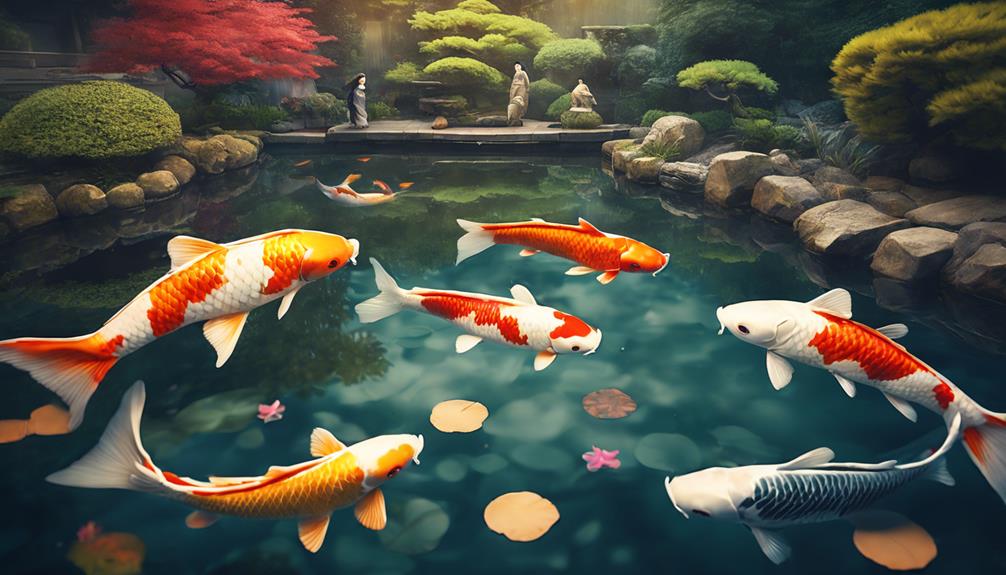
When selecting koi varieties for breeding, it's vital to familiarize yourself with the diverse range of options available, including popular types like Kohaku, Sanke, and Showa, to make informed decisions.
You'll want to choose varieties that thrive in your specific climate and pond conditions, as some breeds are better suited to certain environments than others.
To increase your chances of breeding high-quality offspring, consider the following:
- Select healthy, vibrant fish as breeding stock to guarantee the best outcomes, as they'll pass on their desirable traits to their offspring.
- Research the characteristics of each koi variety, including their color, pattern, and scale quality, to understand what makes them unique and valuable.
- Choose koi that have attributes you want to replicate, such as healthy-looking scales and desired fin shape or color, to increase the chances of breeding high-quality offspring.
Timing Koi Breeding Successfully
To optimize your koi breeding program, timing is crucial, as it directly impacts the success of spawning and the quality of the resulting offspring. You want to guarantee that your koi are healthy and ready to breed at the right time. In general, koi breeding season starts in the spring or early summer, when water temperatures rise above 15°C (59°F).
| Breeding Stage | Timing |
|---|---|
| Pre-breeding preparation | 2-3 weeks before breeding |
| Spawning | Early summer, when water temperature reaches 20-25°C (68-77°F) |
| Egg incubation | 3-4 days after spawning |
| Hatching | 3-4 days after incubation |
| Caring for Young | 2-3 weeks after hatching |
As you take your koi through the breeding process, use a skimmer to remove any debris or unwanted eggs from the water. Be patient and let nature take its course. Monitor water quality and temperature closely, and make adjustments as needed. With proper timing and care, you'll be well on your way to successfully breeding healthy, vibrant koi. Remember, Caring for Young koi requires attention to detail and a clean environment. By following these guidelines, you'll increase your chances of raising a strong, thriving brood.
Frequently Asked Questions
How to Successfully Breed Koi?
To successfully breed koi, you'll need to master the koi selection process, guarantee ideal water conditions, and monitor fish health closely. First, choose parent fish with desirable traits, like vibrant colors, considering genetic variation for a stronger bloodline.
Is Breeding Koi Fish Profitable?
Like a puzzle, breeding koi fish can be profitable, but you need to fit together the right pieces: understanding market demand, managing startup costs, traversing breeding regulations, staying on top of industry trends, and maintaining healthy profit margins, all while making a substantial initial investment.
How to Breed Expensive Koi Fish?
You'll breed expensive koi fish by selecting high-quality broodstock with premium genetics, focusing on rare varieties and color enhancement, and utilizing advanced filtration and water refinement systems to optimize water quality and conditions.
How to Encourage Koi to Spawn?
Like a maestro conducting a symphony, you orchestrate the perfect spawning environment by identifying Spawning Triggers, ensuring ideal Water Quality, pairing Mating Pairs, and preparing the Tank for Natural Stimulation, leveraging Environmental Cues to coax your koi into reproductive harmony.
Conclusion
As you set out on the fascinating journey of koi fish breeding, remember that success lies in attention to detail and a deep understanding of these elegant creatures' needs.
By mastering the 10 essential methods outlined above, you'll be well on your way to propagating vibrant, healthy koi that will thrive in their aquatic haven.
With patience, persistence, and a dash of finesse, you'll discover the secrets of this ancient art, yielding a bounty of breathtaking beauty.

